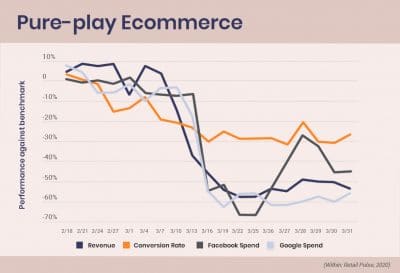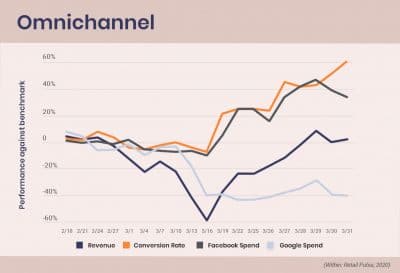Restricted living puts a lid on consumer demand
As we are in the fourth week of the Nordic corona crisis, and the third week of restrictions in Sweden and full lockdown in Finland, there is a sense that people are adjusting to the circumstances. While things are far from normal, we can already get a sense of how the world is shaping to be. (See Sasu Ristimäki’s blog)
The first signs of a slowdown in the corona outbreak in the Nordics become evident, data of dramatic shifts in consumer behaviour during lockdown is coming in. For some time to come, consumers will still be entrenched in the Restricted Living – phase, characterised by consumption decline in everything but essentials (See our Covid-19 Response Digest #2). The economy is presently undergoing a massive slowdown that will most likely last for the next 3-6 months. So far the crisis has disproportionately affected consumer spending, with discretionary retail facing the biggest challenges. European B2B data is still scarce, and the impact appears to have been less severe than anticipated in the short term, but crumbling supply chains and general investment hiatuses will likely affect industrial trade after a slight delay.
US data indicates that omnichannel retailers’ eCommerce volumes have bounced back to pre-crisis levels, while pure-play eCommerce volumes linger at -30% of pre-crisis. The interpretation is that while consumer demand is severely depressed, an omnichannel shift from physical to digital has maintained online revenue levels, while overall demand for all channels is significantly down. We will follow up with data from the Nordics as soon as they become available.


Marketers make major budget adjustments
Lockdowns have caused major shifts in media behaviour with TV and online consumption soaring. As consumer demand starts to pick up, a permanent long term shift towards online media time spend is to be expected.
Most marketers have made significant campaign cancellations, cuts and re-allocations in budgets. Avaus will report the results of our ongoing marketing spend survey in our next newsletter and an upcoming webinar.
As a follow up on our previous Covid-19 Response Digest from last week, we are now publishing our second set of six recommendations for marketers:
Avaus recommendations for marketers part 2 – Mid-term actions
1. Start to prepare for the New Normal
As lockdowns will be eased step by step, customers will only gradually return to their routines. There will be lasting shifts in behaviours, and marketers need to understand and evaluate the shifts in preferences and demand. Use analytics extensively to understand any meaningful shifts in needs and behaviour to enable key new opportunities and the potential for innovation.
2. Improve customer profitability by keeping customer acquisition costs low, and instead invest in high-value customer retention
Keep the focus on existing customers with special attention to high-value customers and long term relationships. Assess segmentation quality and allocate resources to upgrade loyalty programs and activities. Low or negative yield customer relationships should be terminated to free up resources for high-value segment services and activities. Get ready for up- and cross-sell activation.
3. Increase marketing efficiency by 25%
The previous downturn during the financial crisis of 2007-2008 saw a rapid transition from traditional media to own digital channels, marketing automation and the birth of real-time-bidding (2009). This time marketers will have to innovate, look for efficiencies and performance metric-based investments. Long term investments in brand building have to be put on hold. Automation will be needed to replace tasks and hours of content management and production. Sales & Service functions must look for efficiencies through analytics, tech and automated processes.
4. Increase media efficiency by 25%
Biddable digital media, as well as other media costs, will decrease. Programmatic media costs have gone down by -25% during the outbreak, but low customer demand is reflected in a conversion decline as well. The utilisation of data assets should be increased in all media activities. Cloud-based GDPR compliant first- and third-party integration should be in place to enable lower media spend with higher efficiency. Google Cloud and Algorithmics should be household names in all companies – both big and small.
5. Improve online experiences
As online transaction volumes rise, your continued ability to invest in your eCommerce initiatives will be vital. Personalisation, recommendations and frictionless experiences are mandatory. Online shopping in several segments has been negatively impacted during the crisis but is estimated to rebound rapidly as we enter the new normal. Do not stop investing in your eCommerce development initiatives that provide a competitive edge during the bounce-back of customer demand.
6. Data should be your single source of truth
Data-driven decisioning is required to address new needs, make the right choice of which of your customers have the highest potential, and which processes should be automated. Automation is instrumental in your efforts to minimise waste and maximise output. You will need access to high quality, integrated digital and non-digital data in real or near-real-time. You should have a single source of truth and a way to activate the data for communication, reporting and in processes. Without this, you will not be able to streamline marketing operations and increase efficiency. Be pragmatic and aim for rapid improvements in your data literacy and ability to act upon data. Be careful not to embark on large enterprise data integration projects with uncertain long-term outcomes.
Turning data into business results with Emma Storbacka
Recommendations for the mid-term (Q3-Q4/2020) and long-term (2021 onwards) will follow shortly.